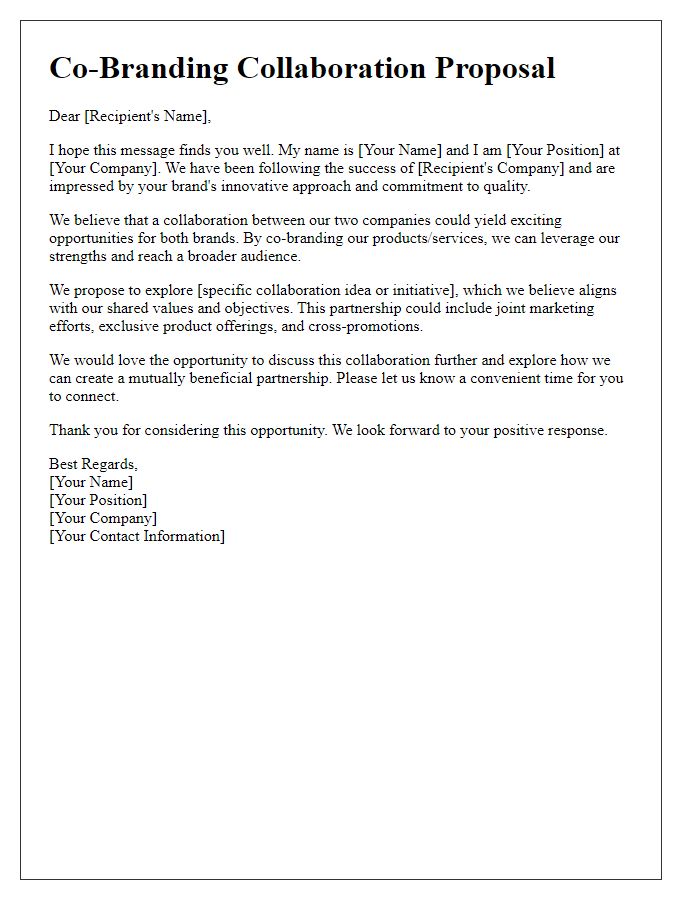Are you looking to elevate your brand's presence and create meaningful connections? A well-crafted letter for a brand collaboration proposal can set the stage for exciting opportunities and partnerships. In this article, we'll explore key elements to include in your proposal, ensuring it resonates with potential partners and showcases your brand's unique value. Ready to take your collaboration game to the next level? Let's dive in!

Brand alignment and values
An effective brand collaboration proposal must emphasize shared values and alignment between two entities. For instance, a partnership between Patagonia, renowned for its environmental activism, and Allbirds, a footwear brand committed to sustainability, can illustrate complementary missions. Both companies advocate for eco-friendly practices, such as using recycled materials and reducing carbon footprints. Highlighting joint initiatives, such as ocean cleanup events or educational campaigns on sustainable consumerism, reinforces the synergy of their brand identities. This alignment not only resonates with environmentally-conscious consumers but also amplifies their collective impact on promoting sustainability in the fashion industry.
Audience demographics and engagement
Audience demographics and engagement play a crucial role in brand collaboration proposals. Understanding the target audience, such as age (18-34 years old), gender (60% female), and geographical distribution (predominantly urban areas like New York City, Los Angeles) enhances the proposal's effectiveness. Engagement metrics, including average engagement rate (5% on social media platforms) and interaction statistics (20,000 monthly website visits), highlight audience interest. Additionally, measuring brand loyalty through repeat purchase rates (40% return customers) illustrates consumer commitment. Sharing insights from audience surveys (90% positive feedback on previous collaborations) can further substantiate the proposal's appeal, establishing a strong foundation for potential partnership success.
Collaboration goals and objectives
A brand collaboration proposal outlines specific goals and objectives to create a mutually beneficial partnership. These objectives typically include increasing brand visibility, enhancing product offerings, and expanding market reach. Identifying shared values between brands, such as sustainability in the case of eco-friendly companies, can strengthen the proposal. Metrics for success, such as a targeted percentage increase in sales or social media engagement, provide concrete benchmarks for evaluation. Additionally, establishing a timeline for milestones, like product launches or joint marketing campaigns, ensures accountability. Collaboration can involve co-branding initiatives, influencer partnerships, or experiential marketing events that maximize audience engagement.
Proposal specifics and deliverables
A brand collaboration proposal outlines specific terms and deliverables that align both parties' goals. This document typically includes a detailed overview of the campaign objectives, such as increasing brand awareness or driving sales, as well as key performance indicators (KPIs) to measure success. The proposal may outline deliverables like social media content (e.g., Instagram posts, TikTok videos), blog articles, and promotional events. It should specify timelines, indicating launch dates and feedback periods, alongside the budget required to execute the collaboration effectively. Additionally, the proposal may include target audiences, such as demographics (age, gender, location), to ensure the partnership reaches the desired market segment. Clear, strategic communication is essential for achieving mutual benefits in such collaborations.
Mutual benefits and ROI potential
A collaboration between two brands can create significant mutual benefits and enhance return on investment (ROI) potential. Co-branding initiatives allow for shared marketing resources, optimizing promotional budgets for better reach. By leveraging each brand's strengths, such as established customer loyalty or innovative product lines, both entities can tap into new markets, potentially increasing sales revenue by up to 30%. Joint events like product launches or promotional campaigns in high-traffic locations can drive customer engagement, resulting in a measurable increase in brand visibility. Collaborations can also involve cross-promotion on social media platforms, accessing wider audiences and enhancing digital footprint. Insights gathered from consumer interactions can further inform future strategies, maximizing customer satisfaction and retention rates.
Letter Template For Brand Collaboration Proposal Samples
Letter template of cooperative marketing proposal for brand collaboration

Letter template of influencer partnership proposal for brand collaboration












Comments